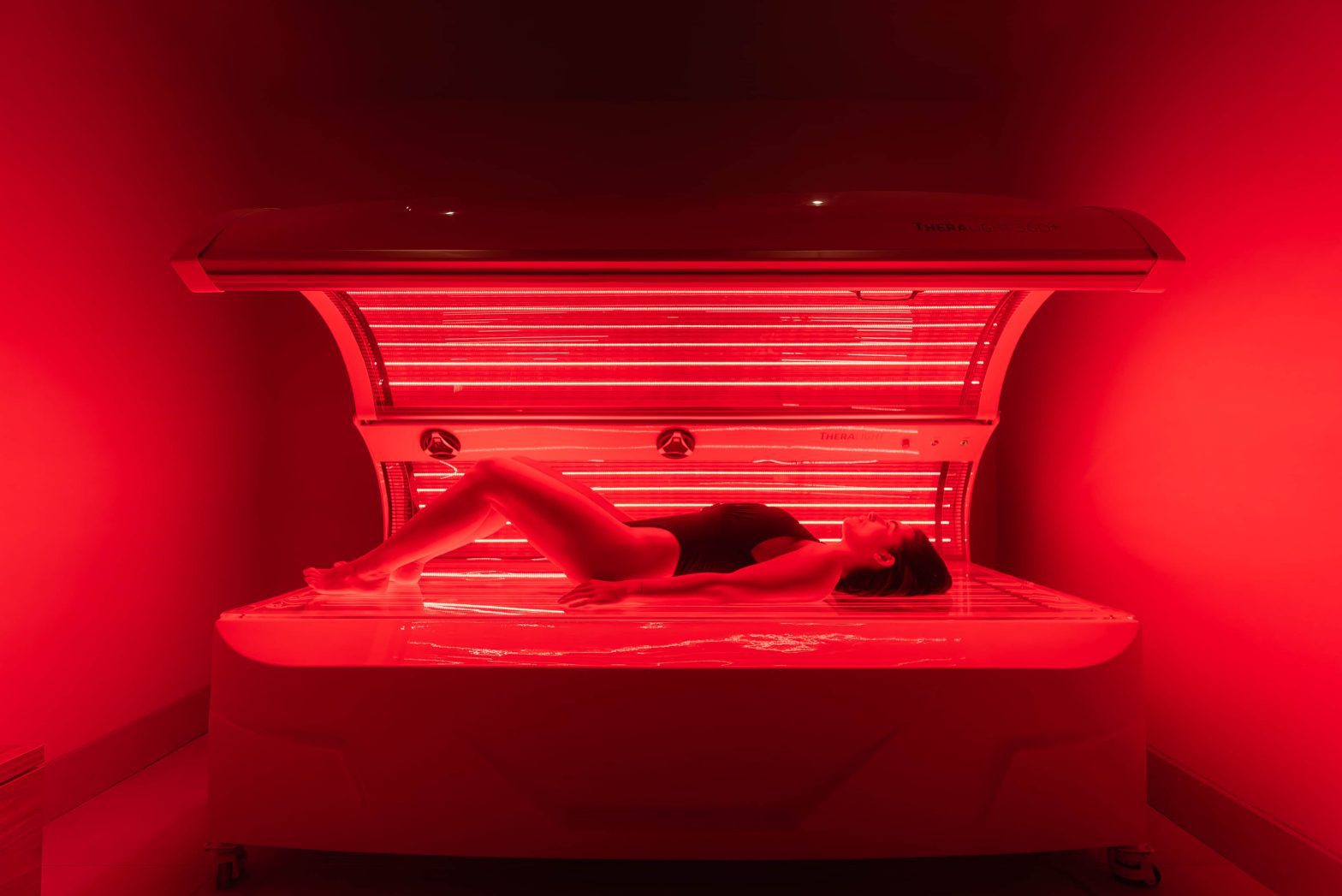Red light therapy has been making waves in the industry recently with all its great work in anti-ageing, but also targeted treatments. Some research suggests that it can be an effective treatment for eczema and psoriasis. Infrared saunas are better for muscle recovery and relaxation, and it’s a very common practice for athletes after strenuous sessions. Today we’re looking at the differences and benefits between each of these treatments, so keep reading to learn more!
Red light therapy vs infrared sauna: what’s the difference?
Red light therapy
Red light therapy is a relatively new technique that’s been designed to improve overall health and physical appearance. It uses low-level red and near-infrared light to stimulate the production of collagen and elastin within the body, while also improving circulation and reducing inflammation. Red light therapy is a popular treatment for people looking to boost their appearance, but there are many other benefits aside from this.
Red light therapy has shown promising benefits in treating a variety of skin conditions, such as wrinkles, scars, stretch marks, psoriasis, acne, eczema, rosacea, and more. The red light heats your skin and penetrates to stimulate the body’s responses, and it’s not uncommon to feel mild feelings of sunburn after longer treatments.
Benefits of Red light therapy
Can promote healing by reducing inflammation
A common use of red light therapy is for healing, whether that be scars, imperfections on the skin, or literal open wounds. Shining red light on the affected skin has been shown to promote healing and remodel the skin to reduce inflammation, which can also promote quicker healing than without. Shining red light on lymph nodes can also reduce inflammation or edema, which can save you a lot of pain after each session. Red light therapy’s applications are broad, so many people find it effective for a vast range of things!
It’s a great anti-ageing tool
One of the most popular uses of red light therapy is for anti-ageing purposes, as this is what most of the research into it has been about. One study confirmed that using red light therapy was an effective form of anti-ageing, with the results lasting up to one month after the treatment. Another study found that full-body treatments were a safe and non-ablative way to treat skin tissue with high satisfaction rates. It can reduce fine lines, wrinkles, skin roughness, and boost the production of collagen, making your skin appear more youthful and glowy.
Possible treatment for atopic ailments like eczema and psoriasis
Research is beginning to indicate that red light therapy can be used for more than just anti-ageing, such as treating ailments like eczema and psoriasis. One research group, using 32 trials and 1,129 randomised participants, found red light therapy effective at improving symptoms of atopic eczema. They also noted improved physician-rated signs, all without a difference in withdrawal due to adverse effects. More research is needed, but pilot studies into this topic are looking extremely promising!
Infrared saunas
An infrared sauna is a type of sauna that uses dry heat that’s created by infrared light instead of fire. Instead of the sauna’s air being heated up around you, the infrared light instead targets your body, heating that up directly instead. This makes the environment of the sauna much more comfortable for many people, although you’ll still be able to enjoy the health benefits.
Infrared saunas still make you sweat vigorously and increase your heart rate, but you’ll be sitting in a clearer room without the heavy humidity weighing down on you. Infrared saunas are becoming more popular for exactly this reason, so if you’ve tried a traditional sauna before but didn’t like the oppressive, hot environment, an infrared sauna might be the perfect alternative.
Benefits of infrared saunas
Can reduce cardiovascular risk factors
One of the biggest benefits of infrared saunas is the potential for them to reduce risk factors associated with cardiovascular health. While research is still ongoing and in its initial stages, it’s important to understand the potential benefits here. A group of researchers looking into this topic found high-quality evidence to support the use of infrared saunas for the treatment of systolic hypertension and chronic pain.
Evidence that it can also treat chronic fatigue syndrome is weak but still possible, and some studies show that infrared saunas can help with weight loss, high blood pressure, and glucose levels. It’s incredibly important that you talk to your doctor before using infrared saunas if you’re suffering from any cardiovascular risk factors to make sure it’s safe for you.
Improves post-exercise muscle soreness
Infrared saunas can also be used after exercise to help boost recovery so you’re not so sore the next day. This not only makes your everyday life easier and more enjoyable, but it also means you can get back to exercising again quicker without the risk of more pain or injury. One study of 16 male basketball players showed that the group that followed their exercise session with a 20-minute infrared sauna session at 43 degrees felt less muscle soreness. They also enjoyed a mood boost thanks to the less severe pain, and they found themselves ready to exercise again quicker than the group who didn’t use the sauna after exercise.
Has the potential to reduce the risk of Alzheimer’s
Infrared light is now being used and studied for many medical purposes, and one of the most positive ones is its effect on Alzheimer’s disease. Infrared saunas have been shown to boost blood flow, while Alzheimer’s is associated with a gradual decrease in brain blood flow. One study on mice exposed them to infrared light for five months, with the results indicating that infrared saunas might have beneficial biological effects in mice suffering from Alzheimer’s disease. Of course, more research is needed for the effects on humans, but this is a very promising start.
Red light therapy vs infrared saunas: which is best for you?
Red light therapy and infrared saunas are both very different applications, despite them looking vaguely similar from the outside looking in. Red light therapy is often considered best for targeted purposes like pain relief, anti-ageing benefits, skin therapy, and wound healing. It’s often used in medical settings for all sorts of purposes, but you can also seek it out yourself and even buy small red light therapy masks and belts for targeted benefits.
On the other hand, infrared saunas come with a lot of benefits that traditional saunas have – they simply feel more comfortable for the majority of users. Infrared saunas are best if you’re looking to generally detoxify your body, relax, purify your skin, and more.
Whether you choose red light therapy or infrared sauna will ultimately depend on what you want to get from each of your sessions. Both are effective holistic treatments and there’s no reason why you can’t use both at the same time, especially as they achieve different beneficial results. If you have any pre-existing health conditions, we’d recommend talking to your doctor beforehand to make sure they give you the green light first.
Frequently asked questions
Is red light therapy the same as infrared saunas?
No, red light therapy isn’t the same as infrared saunas – despite them both using infrared light. Red light therapy uses infrared light with a lower energy level, while infrared saunas use a higher amount of energy.
Red light therapy is mostly used for reducing the signs of aging (fine lines and wrinkles), fading scars, reducing inflammation, effectively reducing pain, and improving skin health.
On the other hand, infrared saunas are mostly used for relaxation, detoxification, boosting weight loss after exercise, improving overall well-being, and increasing metabolism.
Can you do red light therapy with infrared saunas?
Yes, unless your healthcare provider has stated otherwise, there should be no reason why you can’t use red light therapy alongside infrared saunas to make the most of both benefits.
Final thoughts
Both red light therapy and infrared saunas use red light, but it’s the way its used that makes the benefits completely different. Red light therapy is often considered best for targeted treatments, whether that’s anti-ageing, skin conditions, or something else. On the other hand, infrared saunas are best suited for relaxation and muscle recuperation. It all depends on what you’re hoping to get out of your treatment as to which holistic option you go for.




